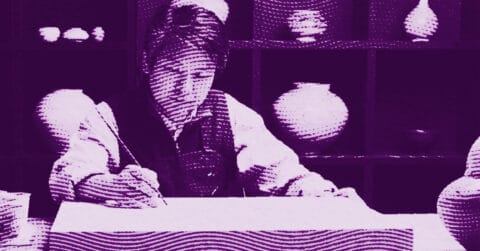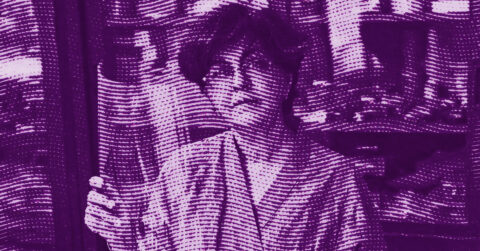Listen to me carefully, you bunch of snobs. I am going to tell you about an artist who, like a mischievous magician in the workshop of art history, transforms the tradition of European portraiture into a captivating surreal spectacle. Ewa Juszkiewicz, this Polish prodigy who emerged from the mists of Gdańsk, does not merely paint, she deconstructs, reinvents, and upends our certainties about female representation in art.
In her Warsaw studio, where vintage wigs and precious fabrics pile up like backstage in a baroque theater, Juszkiewicz orchestrates a pictorial revolution both subtle and radical. She takes hold of the classic portrait codes of the 18th and 19th centuries with impeccable technical mastery, but it is to better subvert them. Her paintings are like poisoned candies, seductive on the surface but bearing a biting social critique.
Let us take a moment to contemplate her technique. Each painting is a technical tour de force requiring several weeks of meticulous work. She applies paint in successive layers, using glazes like the old masters, creating surfaces that capture light with an almost indecent sensuality. The fabrics under her brush come alive, lace breathes, shimmering silks hypnotize us. It is precisely this technical virtuosity that makes her intervention so striking; she perfectly masters the codes she chooses to transgress.
But here is where Juszkiewicz’s genius truly reveals itself: where her female subjects’ faces should be, she creates spectacular absences. Masses of hair sculpted like hallucinatory topiaries, draperies that seem to have come to life, bouquets of flowers that appear to have spontaneously sprung from lace collars, all masks that simultaneously conceal and reveal. It is in this tension between presence and absence that the full strength of her work lies.
This radical artistic gesture takes us directly to Walter Benjamin’s reflections on the technical reproducibility of art. In his fundamental 1935 essay, Benjamin questioned the notion of aura in art in the age of mechanical reproduction. Juszkiewicz, in reinterpreting historical portraits, does not content herself with reproducing them; she breathes a new aura into them, creating works that are both tributes and acts of rebellion. She forces us to question: what constitutes the authenticity of a work of art? Is it its fidelity to a tradition, or its ability to transcend that tradition to create something radically new?
This question of authenticity brings us to a major aspect of Juszkiewicz’s work: her relationship with the history of female art. She particularly dialogues with the work of Élisabeth Vigée Le Brun, the extraordinary portraitist of the 18th century who was the official painter of Marie Antoinette. Vigée Le Brun managed to assert herself in a male-dominated artistic world, creating portraits that, while respecting the conventions of her time, succeeded in infusing her subjects with remarkable vitality and presence. Juszkiewicz takes up this thread but weaves it into a decidedly contemporary tapestry.
The way she manipulates the traditional elements of aristocratic portraiture is particularly fascinating. The sumptuous clothes, sparkling jewels, elegant poses, all these markers of social status are meticulously reproduced, but their meaning is completely overturned by the absence of the face. It’s as if she is telling us: “Look how absurd these conventions are, how arbitrary these codes are.” The fabrics that engulf the faces of her subjects become a powerful metaphor for how society stifles female individuality under the weight of expectations and conventions.
In this first part of the analysis, we see how Juszkiewicz uses pictorial tradition as a tool to deconstruct social norms. But this is only the beginning of her artistic project. Because beyond social critique, there is something deeper at play in her canvases, an exploration of the very nature of identity and representation.
The second part of her work plunges us into even murkier waters. Because while Juszkiewicz masters the art of concealment, she also excels in that of revelation. Her botanical and textile masks are not mere obstacles to our gaze, they are invitations to see differently. By replacing faces with arrangements of flowers, tangles of hair, or complex drapery, she creates what I would call an “aesthetic of overflow.”
This notion of overflow is central to her work. The elements that replace the faces always seem on the verge of escaping all control, as if nature itself were rebelling against the constraints of classical representation. These explosions of organic matter remind us of Georges Bataille’s reflections on the formless, that tendency of matter to overflow the categories we try to impose on it. In Juszkiewicz’s portraits, the formless takes possession precisely of the place where Western pictorial tradition places the seat of identity and reason: the face.
Let us consider for a moment the historical significance of this gesture. In the European portrait tradition, the face was the privileged place for expressing individuality and social status. Portraitists of the 18th century, in particular, excelled in the art of representing their subjects both flatteringly and recognizably, creating images that served both as social documents and assertions of power. By systematically erasing these faces, Juszkiewicz does not merely criticize this tradition, she completely reinvents it.
Her work invites us to reflect on the very nature of female identity in the history of art. The women portrayed in historical portraits were often reduced to archetypes: the noble virtuous lady, the young innocent beauty, the respectable matron. Their faces, with carefully composed expressions and idealized features, were less representations of individuals than social masks. By replacing these faces with masses of sculpted hair or floral arrangements, Juszkiewicz only makes explicit what was already implicit in these portraits: their deeply artificial nature.
Hair, in particular, plays a major role in her work. In 18th-century society, hairstyle was an important social marker, subject to strict codes and changing fashions. Women of high society wore elaborate hairstyles that could reach dizzying heights, requiring hours of preparation and the help of many servants. By transforming these hairstyles into masks that literally devour her subjects’ faces, Juszkiewicz turns a symbol of social control into an expression of anarchic rebellion.
This transformation is especially evident in her works where hair seems to have acquired a life of its own, twisting and intertwining like Medusan snakes. These compositions remind us that hair has always been a site of tension in the representation of the feminine, both a symbol of seduction and an object of social control. By freeing hair from its historical constraints, Juszkiewicz also symbolically frees her subjects from the social constraints that defined them.
The way she treats historical fashion is equally revealing. The sumptuous dresses, the jewelry, the accessories, all these elements that in the original portraits served to assert the social status of the subject, are reproduced with painstaking precision. But by associating them with masked or transformed faces, she reveals their deeply theatrical nature. These garments are no longer symbols of power and prestige but costumes in a social masquerade.
The dialogue that Juszkiewicz establishes with the history of art is not limited to simple appropriation. She creates what I would call a “critical archaeology” of the female portrait. By excavating the conventions of the past, she does not merely expose them to our contemporary gaze; she transforms them into something radically new. Her paintings are like visual testimonies where past and present overlap and intertwine, creating images that are both familiar and profoundly disturbing.
This disruption of our visual expectations is reinforced by her impeccable technical mastery. The precision with which she reproduces traditional elements of the portrait, the textures of fabrics, the sparkle of jewelry, the subtlety of skin tones, makes her surrealist interventions all the more striking. It is precisely because she perfectly masters the language of traditional painting that she can subvert it so effectively.
It is interesting to see how her work dialogues with contemporary concerns while remaining deeply rooted in pictorial tradition. Her portraits speak to very current issues: gender identity, the power of images, the social construction of the feminine, but they do so through the prism of art history. This tension between past and present, between tradition and subversion, gives her work a particular depth and resonance.
The philosophical implications of her work are considerable. By systematically masking the faces of her subjects, Juszkiewicz forces us to question the very nature of identity and representation. What constitutes a portrait? Is it physical resemblance, the capture of a personality, or something more elusive? Her works suggest that identity itself may be less a fixed essence than a series of masks we wear and exchange.
This reflection on the nature of the mask brings us back to the question of power and representation in art. The historical portraits she reinterprets were instruments of social power; they served to affirm and perpetuate class and gender hierarchies. By transforming these images, Juszkiewicz doesn’t merely criticize them, she reinvents them as spaces of possibility and transformation.
Her work invites us to rethink not only our relationship with art history but also our understanding of the present. In a world saturated with images, where representations of the feminine are more codified and commercialized than ever, her masked portraits remind us of the constructed and contingent nature of these representations. They suggest that behind every “perfect” image lies an absence, a void, a possibility for subversion.
As we contemplate these absent faces, these vegetal masks, and sculpted hair, we are invited to participate in a form of visual resistance. Juszkiewicz shows us that it is possible to appropriate the codes of the past not to perpetuate them, but to transform them into tools of critique and liberation. Her work reminds us that the most striking art is often that which knows how to use tradition as a springboard toward radical innovation.
















